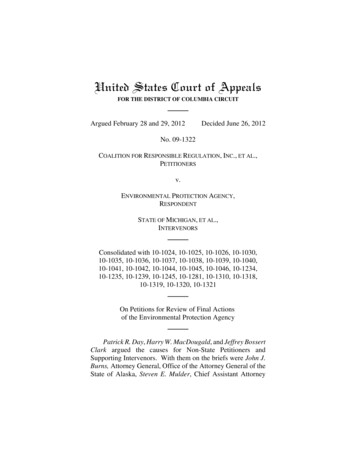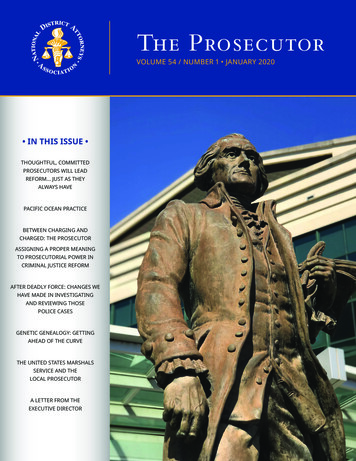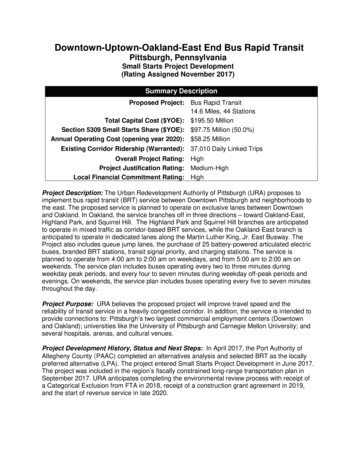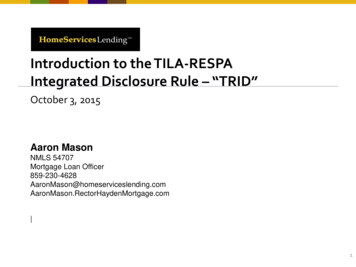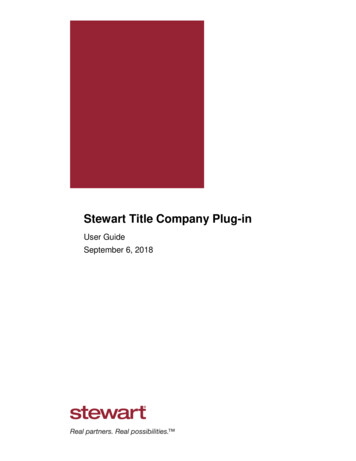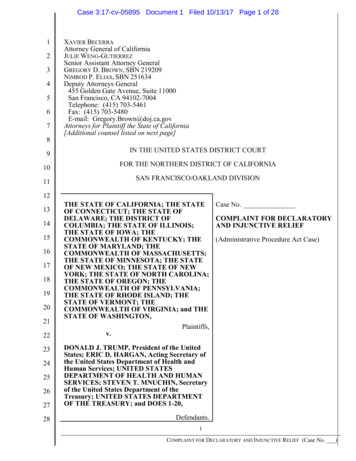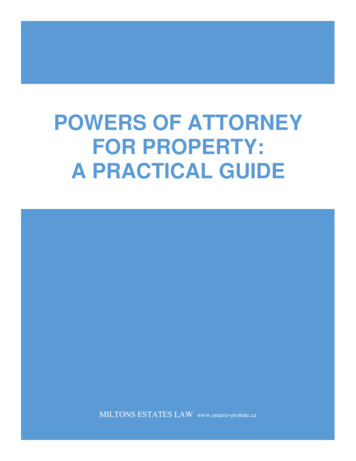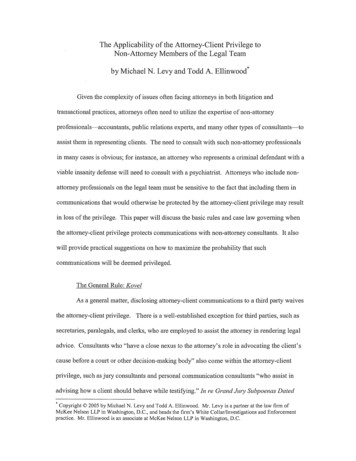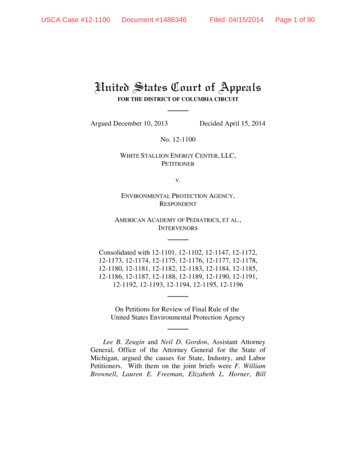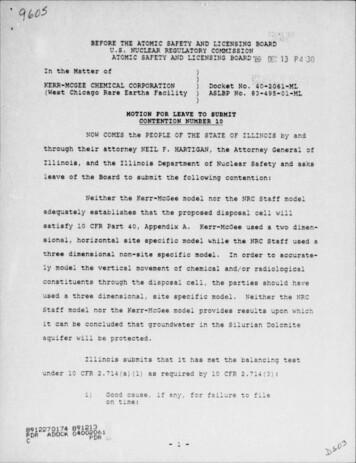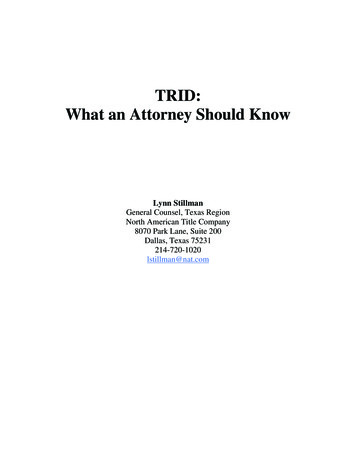
Transcription
TRID:What an Attorney Should KnowLynn StillmanGeneral Counsel, Texas RegionNorth American Title Company8070 Park Lane, Suite 200Dallas, Texas 75231214-720-1020lstillman@nat.com
Lynn StillmanNorth American Title CompanyLynn Stillman is the Texas General Counsel for NorthAmerican Title Company. She supports the North AmericanTitle branches throughout the state with effective legal counsel,ensuring their transactions close seamlessly and with the leastamount of risk for all parties involved.Lynn has ten years’ experience in the Texas title industry.Before joining North American Title Company, she served asSenior Vice President and Corporate Counsel for twoindependent title agencies in the Dallas area. Lynn hasexperience in handling regulatory, compliance and corporatematters, as well as closing, staffing, training, business development and administration.Lynn is an alumni of the 2015 TLTA Leadership Academy, member of the TLTA Regulatoryand TLTA Institute committees and the MetroTex Forms and Contracts committee. As a TRECand TDI-certified instructor, Lynn enjoys creating and teaching classes to help educate the titleand real estate communities.Lynn earned her Bachelor of Arts from Michigan State University and her Juris Doctorate, CumLaude, from Michigan State University College of Law. She was admitted to the State Bar ofTexas in 2006. As a resident of Dallas County, Lynn enjoys spending time with her husband,Daniel, their daughter, Isabel, and dog, Quincy.2015 Texas Land Title Institute – TRID: What an Attorney Should Know2
Table of ContentsI.History of the Final RuleII.Applicable LoansIII.Advising Private LendersIV.How to Explain the Title Premiums DisclosedV.Timeline for Disclosures to ConsummationVI.Revisions to the Closing Disclosure and Re-disclosure RequirementsVII.Protecting Privacy is a PriorityVIII. Violations of NoncomplianceRESOURCESConsumer Financial Protection plementation/tila-respa/Texas Land Title Association (TLTA)http://www.tlta.com/Tlta/American Land Title Association (ALTA)http://www.alta.org/North American Title Company’s CFPB pxEXHIBITSEXHIBIT A:Page-by-page view of the TRID FormsEXHIBIT B:ALTA Settlement StatementEXHIBIT C:Texas Disclosure Form T-64EXHIBIT D:3-Day Closing Disclosure Requirements Timeline2015 Texas Land Title Institute – TRID: What an Attorney Should Know3
TRID: What an Attorney Should KnowThis paper is intended as an informative discussion and resource to title professionals about thenewly implemented TILA-RESPA Integrated Disclosure rules established under the ConsumerFinancial Protection Bureau. THIS PAPER IS NOT A DEFINITIVE EXPLANATION OFTHE LAW AND SHOULD NOT BE CONSTRUED OR RELIED UPON AS LEGALADVICE.I.History of the Final RuleIn response to the financial crisis that precipitated the latest “Great Recession,” in2010 Congress passed the Dodd-Frank Wall Street Reform and Consumer ProtectionAct (Dodd-Frank Act) which created strict rules for lenders to provide increasedtransparency for consumers. The new law included the creation of the ConsumerFinancial Protection Bureau (CFPB) to bring all consumer protection laws under oneumbrella. One of the mandates for the CFPB was to combine the complicated closingdisclosures required under the Truth in Lending Act (TILA)) and the Real EstateSettlement Procedures Act (RESPA) into a more understandable, transparent andintegrated platform, now known informally as the TILA RESPA IntegratedDisclosures rule (TRID). The CFPB’s Final Rule, announced on November 20, 2013and clarified by the CFPB on October 10, 2014 and January 20, 2015 (Final Rule),resulted in the creation of the new Loan Estimate (LE), under sections 1026.19(e) and1026.37 and the new Closing Disclosure Form (CDF) under sections 1026.19(f) and1026.38. The CDF is designed to work with the LE so that loan terms are more clearand transparent and the borrowers can easily compare the loan terms promised themwith the final CDF. Attached as Exhibit A is a 12 page brochure providing an indepth page-by-page view of the three-page LE and five-page CDF.II.Applicable LoansThe lender generally makes the determination as to whether the Final Rule applies toa specific transaction. However, it is important to understand the applicability in orderto determine which forms need to be used at the closing. Under the Final Rule, thenew forms must be used for most closed-end consumer mortgages. For the most part,the Final Rule will apply to residential transactions and not commercial transactions.Closed end is defined as loans where the money loaned is being used for personal,family or household purposes and the debt is secured by real property. Be mindfulthat applicability is determined by the purpose of the loan not the property type, so itis important to rely on the lender’s instructions as to which rules apply. This includesloans on secured properties covering 25 acres or more, loans secured by vacant landon which a home will be constructed or placed using the loan proceeds within twoyears after settlement and temporary construction loans secured by real estate.Per section 1026.19 the Final Rule does not apply to certain types of loans, such as:2015 Texas Land Title Institute – TRID: What an Attorney Should Know4
Home Equity Lines of CreditReverse MortgagesMortgages secured by a mobile home or a dwelling not attached to realpropertyCertain no-interest loans (2nd loans only) made for downpayment or homebuyer assistance, property rehabilitation, energy efficiency, foreclosureavoidance or prevention programsIndividuals who make 5 or fewer mortgages in a calendar year §1026.2(a)(17)If the loan is covered by TILA or RESPA, but not covered under the Final Rule, thelender is required to continue to use current disclosure forms required by TILA andRESPA Regulation Z, such as the GFE, 2010 HUD-1 Settlement Statement andTruth-in-Lending disclosures. Lenders are not prohibited from using the LE and CDFon loans that are not covered by TILA, RESPA, or the Final Rule.Commercial and Cash transactions are also exempt from the Final Rule, TILA andRESPA. Title companies should use their discretion as to what forms to use, such asthe HUD-1 Settlement Statement, ALTA Settlement Statement or the T-60, T-61 orT-62. It is important to make sure that any form used by a Texas title agent ispromulgated by the Texas Department of Insurance.For loans covered by the Final Rule, it is advisable to also use a settlement statementas a supplement to illustrate the receipts and disbursements of the file. A HUD-1Settlement Statement may not be used on any loans covered under the Final Rule.The lending industry has greatly encouraged and accepted the use of the ALTASettlement Statement, attached as Exhibit B. Many lenders are requesting the finalsettlement statements to be provided to them after closing, but it is the titlecompany’s responsibility to make sure the final figures reconcile to the figures on theCDF.III.Advising Private LendersAlthough it is not a title company’s obligation to police lenders and their compliance,title attorneys are often asked to counsel private lenders and/or investors as tocompliance matters. Typically, whether the private lender is a third party or the sellerfinancer, the Final Rule will not apply, unless that individual makes five or moreloans in one calendar year (see §1026.2(a)(17)). If the Final Rule applies, the privatelender will be required to follow the rule, forms and timing and deliveryrequirements. It is important to be careful when counseling lender clients with regardsto compliance because although they might not be subject to the Final Rule, they maybe subject to the separate requirements under RESPA Regulation X or the TexasSAFE Act under Chapter 156 of the Texas Finance Code. See J.C. Fleming, SellerFinancing – When Do the SAFE Act and Dodd Frank NOT Apply? (Texas Land Title2015 Texas Land Title Institute – TRID: What an Attorney Should Know5
Institute, 2014); J. Minke, RESPA: Completing a GFE and HUD-1, Closing TableRequirements (Texas Land Title Institute, 2009); R. Wisner, Real Estate SettlementProcedures Act (RESPA) (Texas Land Title Institute, 1996); and S. Lawrence, RealEstate Settlement Procedures Act of 1974 and the New 1992 Regulation “X” (TexasLand Title Institute, 1993).IV.How to Explain the Title Premiums DisclosedPursuant to 1026.37(g)(4) of the Final Rule, the CFPB requires the CDF to disclosethe title insurance premium for a lender’s title policy to be the full premium rate. Assuch, the premium shown for title policies on the CDF are inaccurate because they donot reflect the simultaneous issue rate provided by R-5 of the Texas Department ofInsurance. Pursuant to procedural rule P-73, the Texas Disclosure Form T-64 mustbe used if a CDF is being used. Attached as Exhibit C, the T-64 form simplifies themath and specifically discloses the premiums accurately. Explaining this toconsumers can be difficult. Below is an example of how to explain it with T-64 andsections of the CDF:Texas Disclosure Form T-64 225,000 Owners Title Premium is 1,429 and the 200,000 Loan PolicyPremium is 100 (pursuant to the simultaneous issue).2015 Texas Land Title Institute – TRID: What an Attorney Should Know6
Closing Disclosure Form - Section B 1,318.00 is charged to Borrower for Lender’s PremiumThe title insurance premium for a lender’s title policy is disclosed at thefull premium rate.Closing Disclosure Form - Section H 211 is charged to Seller for Owner’s PremiumThe title insurance premium for an owner’s title policy is calculated bytaking the full owner’s title insurance premium, adding the simultaneousissuance premium for the lender’s coverage and then deducting the fullpremium for lender’s coverage.Closing Disclosure Form – Sections L & N2015 Texas Land Title Institute – TRID: What an Attorney Should Know7
1,218 is credited to Buyer and charged to Seller as “Title-Adjustment forOwner’s Premium” – So the Seller has paid 211 in Section H and 1218 inSection L to equal 1429, which is the full cost of the Owner’s Title Premium.TRID MATH CALCULATIONS:Actual Cost of the Owner’s policy: 1,429.00 Simultaneous Rate for the Loan Policy: 100.00 Total of Owner’s & Loan Policy: 1,529.00- Amount of Straight Loan Policy (charged to Buyer):- 1,318.00 Owner’s premium shown on CDF: 211.00*Endorsements to the title policy are itemized unless the lender requires itotherwise. Even if the lender instructs you to show the title charges in a differentway, it is important for you and your staff to be able to explain the disclosurescorrectly.V.Timeline for Disclosures to ConsummationPursuant to section 1026.19(f)(1)(v), the consumer must receive the CDF at leastthree (3) business days before consummation of the loan. Consummation is definedunder section 1026.2(a)(13) as the date the consumer becomes contractually obligatedto the creditor, which is typically considered the date the consumer signs thepromissory note. Lenders may consider the CDF received three (3) business daysafter delivery, in which case the waiting period between the delivery of the CDF andclosing will be six (6) business days. Attached as Exhibit D is a timeline illustratingthe three-day waiting rule between receipt of the CDF and consummation of the loan.Because of this waiting period after receipt of the CDF, title companies are oftenasked by borrowers “How can we waive the three day waiting period”? This decisionto waive the requirement is ultimately up to the lender. Under the Final Rule, section1026.19(E)(1)(V), the Consumer may modify or waive the three day waiting period ifthey determine the loan is needed to meet a “bona-fide” personal financialemergency. All borrowers liable on the loan must provide an explanation of thefinancial emergency in writing and specifically modify or waive the waiting period.Lenders are prohibited from providing pre-printed waiver forms and title companiesshould not assist. When asked, title companies should direct the borrower to theirlender since they are responsible for compliance under the Final Rule.VI.Revisions to the Closing Disclosure and Re-disclosure RequirementsRe-disclosure and the re-triggering of the three-day review period is dictatedprimarily by the reason(s) for the required credit/adjustment. Pursuant to section1026.19(f)(2)(ii), if one of the following occurs during the time the CDF is receivedby the consumer and the closing, then the consumer must be provided a new CDF anda new three-day period is triggered:2015 Texas Land Title Institute – TRID: What an Attorney Should Know8
a. The disclosed APR is increased by 1/8th of a percent for most loans and 1/4th of apercent for loans with irregular payments or periods, §1026.22 and§1026.19(f)(ii)(A);b. The loan product previously disclosed changes, §1026.19(f)(ii)(B); orc. A prepayment penalty is added to the loan, §1026.19(f)(ii)(C).Less significant changes to the CDF can be disclosed on a revised CDF and providedto the consumer at or before closing, without delaying the closing. If during closingyou are requested to make changes, you will need to stop and contact the lender forinstructions. Initiating contact with the lender as soon as possible is key.In the event the lender allows you to revise the CDF you can then make the change atthe table, however, approval from the lender to continue may still be required. It iscritical that no changes or adjustments be made “off the sheet” (i.e. handwrittenchanges with initials) unless expressly approved by the lender. Communication withthe lender throughout the transaction as well as knowing who will be available toassist at the hour of closing is crucial for a smooth closing.The only seller-side change that will retrigger the three-day waiting period is if thechange causes the borrower’s side to change in one of the above mentioned areas thattrigger a new review period. Even then, the buyer’s lender may require approval ofcertain seller changes. Minor revisions such as a utility payment should not causeconsummation problems, but getting the revised CDF may take some time. Many realestate professionals are now considering conducting two walk-throughs, one sevendays prior to consummation and one the day of consummation. The sooner changesare communicated to the lender the better the likelihood of the transaction proceedingas scheduled.VII.Protecting Privacy is a PriorityWith the changing environment and the responsibilities of the lender and titlecompany, expect to communicate differently with lenders. The Final Rule requiresthat lenders take measures to secure non-public personal information (NPI). Thismeans you will start receiving encrypted emails from attorney’s offices and lenders.You may have to communicate through various online portals for different lenders.Be prepared for this to take a little longer initially, as you will be required to set upaccounts and passwords.Further, pursuant to the CFPB’s bulletin dated 4/13/12, lenders are expected to havean effective process for managing the risk of their service providers, such as a titlecompany, as defined in section 1002(26) of the Dodd-Frank Act [12 U.S.C. §5481(26)]. Since lenders have direct liability for all actions of their service providers,2015 Texas Land Title Institute – TRID: What an Attorney Should Know9
they have been and will continue to conduct thorough due diligence to verify titlecompanies are capable of complying with federal consumer financial laws. Lendershave been and will continue to request and review title company’s policies,procedures, internal controls and training materials to ensure the title company hasappropriate training and oversight of employees that have consumer contact or accessto NPI. It is advisable that title companies implement ALTA Best Practices for TitleInsurance and Settlement Companies (Best Practices) because many lenders havestarted to require Best Practices compliance by those title companies closing theirloans.VIII. Violations of NoncompliancePursuant to Dodd-Frank, the CFPB has enforcement jurisdiction for both TILA andRESPA, which includes the ability to impose penalties under 12 U.S.C. 5565(a).Depending on the circumstances, penalties could include 5,000 per day for a singleviolation, 25,000 per day for violations shown to be reckless, and 1 million per dayfor committing violations knowingly. It is important to remember that the lender isultimately responsible for compliance with the Final Rule, but the CFPB may extendliability to title companies or attorneys knowingly violating the rules. It is unclearnow, but may become clearer as actions are administered, how violations will beadjudicated. In the event you question compliance with the rule you should obtain allinstructions from the lender in writing to document your file.The coming year of implementing the new laws will be filled with challenges throughout theindustry. However, over time title companies should find themselves more accustomed to thechanges and eventually the requirements under the Final Rule will sooner or later becomebusiness as usual.2015 Texas Land Title Institute – TRID: What an Attorney Should Know10
NORTHAMERICANTITLECOMPANYLike Clockwork www.nat.com/CFPB
UNDERSTANDING THE NEWLOAN ESTIMATE AND CLOSINGDISCLOSURE FORMSAtCLOSING DISCLOSURENorth American Title, we want tomake sure all of our customershave the information they need tounderstand the new Loan Estimateand Closing Disclosure, the twonew mortgage disclosures that will go into effect in2015. This brochure will provide a brief overview ofthe various sections of these two forms.There are many disclosures required to transacta mortgage. These disclosures were createdover many years under the auspices of differentfederal regulators. In 2010, Congress passed theDodd-Frank Wall Street Reform and ConsumerProtection Act (Dodd-Frank Act), which mandatedthese disclosures be combined and streamlinedso it would be easier for consumers to understandthe terms of their loan and to shop for the bestloan terms.The new forms were created to combine thetraditional Good Faith Estimate, Truth in Lendingdisclosure and the HUD-1 Settlement Statementcurrently required under the federal Truth inLending Act (TILA) and Real Estate SettlementProcedures Act (RESPA). The new forms must beused for most closed-end consumer mortgages.However, certain types of loans, such as homeequity lines of credit, reverse mortgages, andmortgages secured by a mobile home or by adwelling that is not attached to real property, mustcontinue to use current disclosure forms requiredby TILA and RESPA.2LOAN ESTIMATEThe Loan Estimate is provided tothe buyer within three businessdays of applying for a mortgageloan. It includes the terms of theloan, the projected payments andan estimate of the closings costs.Since the Loan Estimate is uniformfrom lender to lender, it can be usedto compare and shop around for thebest mortgage to fit a borrower’ssituation.Under the new regulations, theClosing Disclosure must be providedto the borrower at least three businessdays before he or she becomescontractually obligated for theloan (generally when the final loandocuments are signed). Just like theLoan Estimate, the Closing Disclosurelists information about the loan terms,monthly payments and closing costs.These are not estimates, however, butthe actual and final terms of the loan.REMEMBER: The Closing Disclosure is designed to work with the LoanEstimate so borrowers can easily compare the two documents and ensurethey are getting the terms promised to them.IMPORTANT NOTICE REGARDING LIMITATION ON USE OF INFORMATIONThe information in this brochure is provided for general educational purposes only and shouldnot be construed or relied upon as legal advice. This information is provided “as is” without anyrepresentations or warranties, express or implied, including, but not limited to, any representationthat the information is complete, true, accurate, up-to-date or non-misleading. If you havespecific questions about any information provided herein, you should consult your attorney orother professional legal services provider.
PA G E 1APPLICANT, PROPERTYAND LOAN INFORMATIONIdentifies the borrowers, theproperty address, the sale price(or appraised value or estimatedvalue if the loan is a refinance), thelength of the loan and the terms.LOAN ESTIMATELOAN TERMSPROJECTED PAYMENTSCOSTS AT CLOSINGLists the amount the borrower isproposing to borrow, the interestrate, and the monthly principaland interest. Indicates whetherthe loan has any special featuressuch as a prepayment penalty ora balloon payment.Combines the principal andinterest, mortgage insuranceand estimated escrow to showthe estimated monthly payment.Escrow can include taxes,homeowners insurance and otherassessments, if any.The estimated closing costs andthe estimated cash the borrowerwill need to close, which includesclosings costs plus the downpayment. (Explained in moredetail on page 2.)3
PA G E 2LOAN ESTIMATEORIGINATIONCHARGESFees the lendercharges to process,underwrite andfund the loan.SERVICESYOU CANNOTSHOP FORFees for servicesprovided bypersons otherthan the lenderbut required bythe lender in orderto determine if itwill fund the loan.SERVICES YOUCAN SHOP FORAdditional servicesprovided by personsother than the lenderand required to finalizethe loan, but forwhich the borroweris permitted to selecthis or her own serviceproviders.TAXES AND OTHERGOVERNMENTFEESFees required by the localor state government forthe transfer of propertyor for recording themortgage in thecounty records.4PREPAIDSInsurance, taxesand other itemsrequired to bepre-paid atthe time of theclosing of themortgage.INITIAL ESCROWPAYMENT AT CLOSINGThe lender requires the creationof an escrow account from whichto pay various recurring periodicpayments, such as mortgageinsurance, homeowners insuranceand property taxes. This is a listingof initial payments into the escrow.OTHERAdditional payments,such as homeowner’sassociation feesassociated with transferof ownership, homewarranty fees, realestate commissions andowner’s title insurance.CALCULATING CASHTO CLOSECash the borrower willneed to bring to theclosing, including thetotal closing costs plus theborrower’s down payment.It can also include anycredits or adjustments.
PA G E 3LOAN ESTIMATELENDER INFORMATIONCOMPARISONSOTHER CONSIDERATIONSCONFIRM RECEIPTContact and licensinginformation for the lender,loan officer and, if applicable,mortgage broker.This information provides abasis of comparison shouldthe borrower choose to shopfurther for a loan.This section details particularrequirements of the lender andmay change from lender tolender.The borrower signs to confirmthat he or she has received theLoan Estimate. This is NOT afinal loan application and doesNOT obligate the borrower toaccept the loan.5
PA G E 1CLOSING,TRANSACTIONAND LOANINFORMATIONThe closing date andlocation, informationabout the transaction,and the loan lengthand terms.6CLOSING DISCLOSURELOAN TERMSPROJECTED PAYMENTSCOSTS AT CLOSINGThe amount to beborrowed, the interestrate, and the cost ofthe monthly principaland interest. Indicateswhether the loan has aprepayment penalty ora balloon payment.The monthly principal and interest payments. This number,combined with the mortgage insurance and monthly escrowpayment, equals the estimated total monthly payment. Sinceescrow requirements can change over time with the increase ofproperty taxes or homeowner’s insurance, the escrow portion ofthe payment can vary from year to year. Not all fees are paid outof escrow. In this example, the homeowner’s association fees arenot paid out of escrow and are the responsibility of the borrower.Total closing costs andthe estimated cash theborrower will need toclose, which includesclosing costs plus thedown payment. This isexplained in more detailon page 2.
PA G E 2CLOSING DISCLOSURECLOSING COSTDETAILSThis page details all ofthe final closing costs,who is responsiblefor each fee and whatfees have alreadybeen paid.ORIGINATIONCHARGESFees thelender chargesto process,underwrite andfund the loan.SERVICESBORROWER DIDNOT SHOP FORFees for servicesthe lenderordered to makean underwritingdetermination.SERVICESBORROWER DIDSHOP FORAdditional servicesrequired by thelender but selectedby the borrower.TAXES AND OTHERGOVERNMENT FEESFees required by the localand state government forthe transfer of property orfor recording the mortgagein the county records.PREPAIDSFees the borroweris required to payup front, suchas homeowner’sinsurance, mortgageinsurance,pre-paid interestand property taxes.INITIAL ESCROWPAYMENT AT CLOSINGThe lender requires the creationof an escrow account fromwhich to pay future amountsdue for mortgage insurance,homeowners insurance andproperty taxes. This is a listing ofinitial payments into the escrow.OTHEROther payments,such as homeowner’sassociation fees,home warrantyfees, real estatecommissionsand owner’s titleinsurance.7
PA G E 3CALCULATING CASH TO CLOSECash the borrower will need to bring to theclosing, and includes the total closing costsplus the borrower’s down payment. It canalso include any credits or adjustments.8SUMMARIES OF TRANSACTIONSummarizes the transaction for both thebuyer and the seller.CLOSING DISCLOSURECALCULATIONCash the borrower must bring to the closing,and how much the seller will be paid afterall mortgages, judgments, liens and fees duefrom seller are paid at the closing.
PA G E 4CLOSING DISCLOSURELOAN DISCLOSURESESCROW ACCOUNTESCROW ACCOUNT DETAILSFUTURE CONSIDERATIONSSpecial features of the loanthat are required to bedisclosed to the borrower.Explanation of the purposeof an escrow account.Fees required upfront to provide a“cushion” for the escrow account andthe portion of the monthly paymentthat is put towards escrow. It also liststhose fees that are NOT in escrow andwill be paid directly by the borrower.Additional information about the escrowaccount, including what changes mayoccur in the escrow account in the futureand your responsibility to make sure taxesand insurance are paid.9
PA G E 510CLOSING DISCLOSURELOAN CALCULATIONSOTHER DISCLOSURESCONTACT INFORMATIONCONFIRM RECEIPTThe total cost to theborrower over the life ofthe loan.Additional general disclosuresabout the loan.Important contact information forthe service providers who assistedin the property purchase (ifapplicable), as well as processing,funding and closing of the loan.The borrower signs to confirm thathe or she has received the ClosingDisclosure. This does NOT obligatethe borrower to accept the loan.
TITLEESCROWWHAT IS TITLE INSURANCE?WHAT IS ESCROW?Over the years with each new possession of a property, eventsaffecting the title can take place – such as a refinancing, a tax lien, anencroachment by a neighbor, or the marriage, divorce or death of anowner. That’s the case even when buying a newly built home.Escrow is the depositing of funds and documents with a neutralthird party for delivery upon completion of the terms of the escrowinstructions. When the parties deliver documents and money to theEscrow Officer, we say the documents are held “in escrow.” Each ofthe principals of the escrow (seller, buyer and lender) provide writteninstructions setting out the conditions under which further deliveryis to be made.When a buyer and seller agree on a home or land purchase transaction,a title professional searches public records to see if any outstandingissues could affect the new buyer’s rights. This process, called a titlesearch, provides warnings of title flaws that must be resolved beforethe property changes hands. At that point, title professionals work toremedy problems that could prevent the new owners from having a“clear” title.However, the best title search performed by the most experiencedand capable experts cannot ensure that no title hazards exist. To helpprotect the homebuyer, the title professional issues a title insurancepolicy to insure against most of these unforeseen problems.There are two kinds of title insurance policies. An Owner’s Policy assuresthe title company will be there to help pay valid claims and cover thecosts of defending an attack on the homebuyer’s title. A homebuyermust request an Owner’s Policy, since it isn’t always an automatic partof the closing process. In addition, the mortgage lender has a greatfinancial interest in the property. A Loan Policy ensures unforeseentitle problems will not negatively impact a lender’s rights under themortgage agreement.In addition, it’s important to understand title insurance is differentfrom other kinds of insurance, such as homeowners or auto insurance.The premium paid just once for title insurance buys coverage thatlasts the entire time the homebuyers or their heirs own the home.The common use of an escrow is to enable the parties in a real estatetransaction to deal with each other with less risk, since the escrowholder acts as custodian for funds and documents, as well as theclearing house for payment of all demands.Typically, an escrow begins with the Escrow Officer opening the orderfor title work. Based on the information provided, North AmericanTitle searches all public records relating to the property and prepareseither a preliminary report or a commitment, providing the customerwith the conditions on which the title insurer will issue a policy.Upon receipt of the preliminary report or commitment, an analysisis made to determine the necessary action and documents requiredto complete the transaction: demands for satisfaction of liensnot acceptable to buyer and/or lender; documents for recording;instructions; and requirements of the new lender. In most areas,buyers and sellers instructions are prepared for signature from theinformation gathered. When all the title and financial requirementsare met, and instructions from all parties can be fully com
2010 Congress passed the Dodd-Frank Wall Street Reform and Consumer Protection Act (Dodd-Frank Act) which created strict rules for lenders to provide increased transparency for consumers. The new law included the creation of the Consumer . See J.C. Fleming, Seller Financing - When Do the SAFE Act and Dodd Frank NOT Apply?
